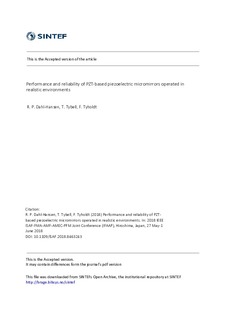Performance and reliability of PZT-based piezoelectric micromirrors operated in realistic environments
Chapter
Accepted version
Permanent lenke
http://hdl.handle.net/11250/2581673Utgivelsesdato
2018Metadata
Vis full innførselSamlinger
- Publikasjoner fra CRIStin - SINTEF AS [5801]
- SINTEF Digital [2501]
Originalversjon
2018 IEEE ISAF-FMA-AMF-AMEC-PFM Joint Conference (IFAAP), Hiroshima, Japan, 27 May-1 June 2018, pp 4Sammendrag
The number of application areas for piezoelectric micro electromechanical systems based on PZT have increased rapidly over the years. Thus, to continue the development towards commercial deployment, characterizing lifetime and reliability during operation in realistic and harsh environments is important. Such environments are demanding for piezoMEMS devices since they often involve high humidity levels and elevated temperatures which gives rise to complex degradation. To address how such conditions affects device performance we combined optical and electrical measurements to elucidate the degradation of a PZT-based thin-film piezoelectric MEMS micromirror during temperature-humidity-cycling tests. As a test structure, 1 μm PbZr 0.40 Ti 0.60 O 3 on a 10 nm LaNiO 3 buffer-layer, were deposited by pulsed laser deposition on platinized Silicon-on-Insulator wafers. A 250 nm Au/TiW top electrode was deposited by DC-sputtering before structuring the final device. The micro mirrors were unipolarly actuated with a signal of 20 V peak-to-peak at a frequency of 1.5 kHz in an ambient with constant vapor concentration of 22 g/m 3 for device temperatures between 25 o C and 175 o C. Humidity-related degradation was manifested as local breakdown events and pinholes on top of and along the edges of the used electrodes. This had a strong effect on device performance and preceded degradation due to polarization-fatigue at all temperatures. Also, both the initial piezoelectric response and number of cycles to device failure increased with increasing substrate temperature in humid ambient. Performance and reliability of PZT-based piezoelectric micromirrors operated in realistic environments
